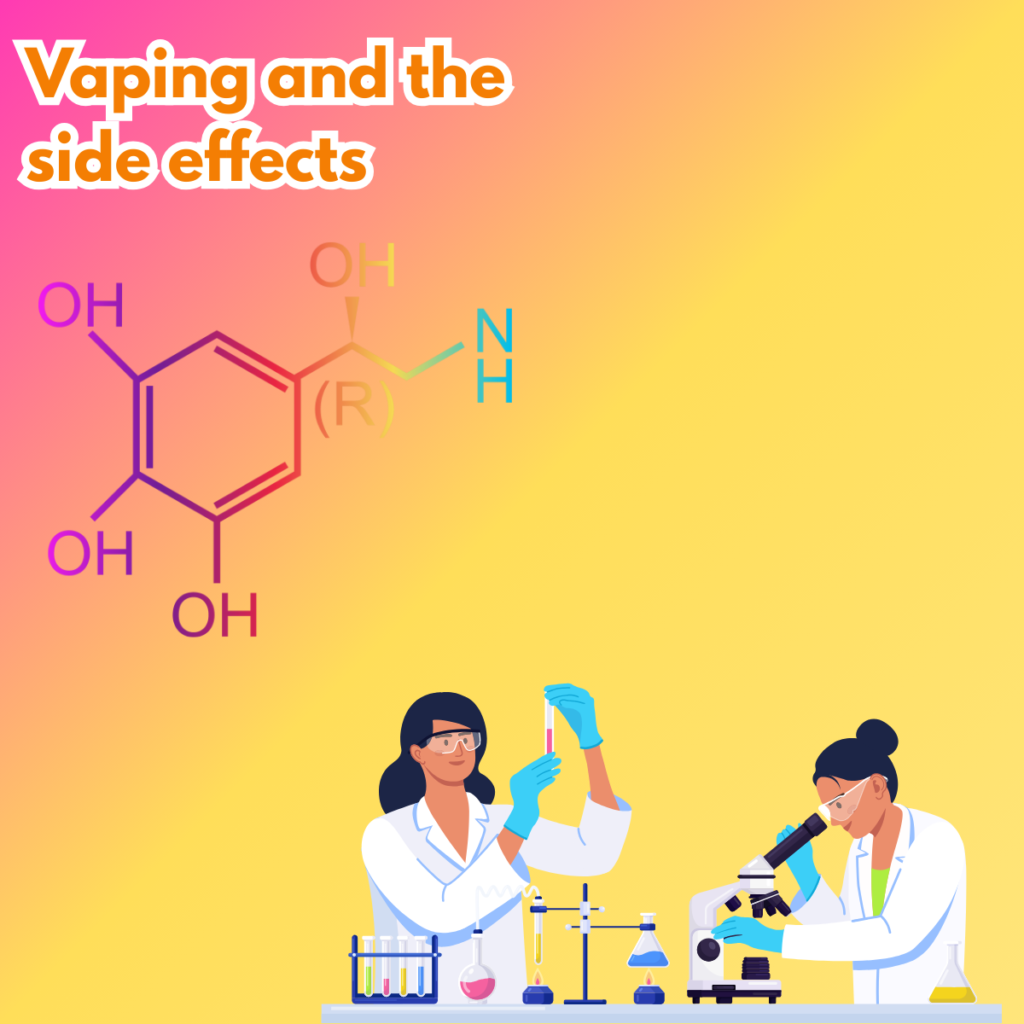While the truth can be hidden in many things, most of the time it’s very obvious. Vaping and the side effects. Here on this post, we will be looking at hard facts about vaping, tests and results. I shall also be giving my personal opinion as a once upon a time heavy vape smoker.
We will be sharing stories and giving insights from news reports and diving into some of the chemistry behind the product. Vaping is an unbelievably controversial topic and even more of a complicated system of effects.
Industry Influence & Lobbying

When vapes were first designed in 1963 (during a tobacco boom), there was a patent on it, so nobody wanted to buy the product. Rather, companies waited for the patent to expire and then produced their own products. Tobacco companies would also threaten or pay off any competitors even thinking of supporting vaping.
In 2004, there was no more denying that vaping was going to change the course of smoking history. Vapes came out and were being sold commercially as a way of “getting off cigarettes.” This slowly became the new-age revolution, although it didn’t always work as intended.
Many people ended up smoking both. Sometimes the opposite effect would take place—someone would start vaping and then end up on cigarettes or rolling tobacco. Statistics show that 30% of young teens and adults who start vaping end up smoking cigarettes in the U.S.
Why Has So Little Research Been Done on Vaping and the Side Effects?

Funny enough, both tobacco companies and vaping companies put a lot of funding into the health research of this product. But why would tobacco companies invest in research on their competitor’s product?
Tobacco companies fund research to debunk vaping, hoping to find something cancer-causing or related to lung disease to damage vaping sales.
Vaping companies do the opposite, funding research to prove that vaping is healthier than smoking cigarettes. The fight goes on, with both sides investing heavily in corporate battles.
Why Is There No Overall Result?

The truth is, there is. As hard as it is to swallow, vaping at the moment stands as the healthier product. However, this is not a definitive fact. Different parts of the world have different regulations on vaping and the side effects.
China, India, and Thailand have banned vaping altogether, while the UK and New Zealand promote it as harm reduction. We are all in suspense to see if there are any unforeseen effects of vaping that might emerge in the next 40 years.
Vaping is also always changing—more and more foreign chemicals are being added to vape flavors every day, different cotton is being used, and less effective coils are appearing.
Environmental Impact of Vaping and the Side Effects

- E-Waste from Disposable Vapes
Most disposable vapes contain built-in lithium-ion batteries that are not easily recyclable. Tossed in the trash, they contribute to battery pollution and chemical leaks into soil and water. - Plastic Pollution
Many vape pods and disposable devices are made from plastic and mixed materials, making them difficult to recycle. Unlike cigarette butts (which are also a massive problem), vape waste includes plastic pods, coils, and packaging, adding to the world’s plastic crisis. - Toxic Chemical Leakage
Leftover e-liquid in disposed pods can leach nicotine, heavy metals, and other toxins into the environment, contaminating water sources and harming wildlife. - Energy & Resource Consumption
Lithium mining (for vape batteries) contributes to habitat destruction and water shortages. The production and shipping of vaping products have a huge carbon footprint, especially for single-use vapes that are discarded quickly. - Poor Recycling Infrastructure
Many countries lack proper recycling programs for vape products. Most people don’t know how or where to recycle used vapes, so they just throw them away.
Vaping and the Side Effects on the Body

Short-Term Effects:
Coughing and shortness of breath – The most obvious yet most harmful part of vaping and the side effects. These chemicals are responsible:
- Diacetyl & Acetyl Propionyl (Flavoring Chemicals) – Found in buttery flavors like popcorn and caramel, can cause “Popcorn Lung.”
- Propylene Glycol (PG) & Vegetable Glycerin (VG) – Main vape ingredients that dry out and irritate the lungs. PG breaks down into formaldehyde at high heat.
- Formaldehyde & Acrolein (Toxic Byproducts) – Formed at high wattages or from dry hits, causing lung inflammation and long-term damage.
- Nicotine (Even in “Nicotine-Free” Vapes) – Increases airway sensitivity and can lead to chronic bronchitis-like symptoms.
- Metal Particles (From Coils) – Vaping releases nickel, lead, and chromium, which may cause lung damage and heavy metal poisoning.
- Volatile Organic Compounds (VOCs) – Found in flavor additives, these can irritate the eyes, throat, and lungs.
Yeah, you should see the list for cigarettes.
Dizziness and Headaches – This is mostly thanks to nicotine. Here’s why:
- Blood Vessel Constriction – Nicotine narrows blood vessels, reducing brain oxygen, causing dizziness and headaches.
- Oxygen Deprivation – It speeds up heart rate but lowers oxygen to the brain, leading to lightheadedness.
- Dopamine Overload – Nicotine spikes dopamine, then crashes, causing fatigue and headaches.
- Dehydration – Vaping dries out your body, triggering headaches.
- Nicotine Overdose – Too much nicotine can cause nausea, dizziness, and headaches.
- Withdrawal Effects – Cutting back on nicotine leads to headaches, dizziness, and brain fog.
Not a fun time—this is exactly why I quit smoking. That, and the next reason.
Increased Heart Rate and Blood Pressure – Another nicotine-driven issue. The reasons are the same as above.
Dry Mouth and Throat Irritation – Caused by the same chemical compounds responsible for coughing and shortness of breath.
Long-Term Effects:
- Heart Issues – Nicotine contributes to high blood pressure and heart disease.
- Lung Inflammation – Some studies suggest vaping could cause lung scarring (e.g., “popcorn lung”).
- Addiction & Withdrawal – Nicotine is highly addictive, leading to dependence.
- Gum Disease & Tooth Decay – Vaping reduces saliva, leading to oral health problems.
Numbers 3 and 4, in my opinion, are the most dangerous vaping and the side effects, especially for younger individuals. I struggled with addiction and stress due to nicotine.
I also had terrible teeth and frequently visited the dentist. While not solely caused by vaping, it was a significant factor.
The reality is, vaping and the side effects are still evolving, and while it’s a harm reduction tool for many, it comes with risks that shouldn’t be ignored.
Conclusion
Vaping and its side effects remain a constantly evolving discussion, with research, industry influence, and public opinion shaping the narrative. While it may be a less harmful alternative to smoking, it’s far from harmless. From environmental concerns to health risks, there are undeniable downsides that shouldn’t be ignored.
At the end of the day, the choice to vape is personal, but it should be an informed one. If you’re considering vaping, weigh the risks carefully, stay updated on new research, and make decisions that align with your health and lifestyle goals. And if you’re already vaping, maybe now’s a good time to rethink whether it’s doing you more harm than good.



